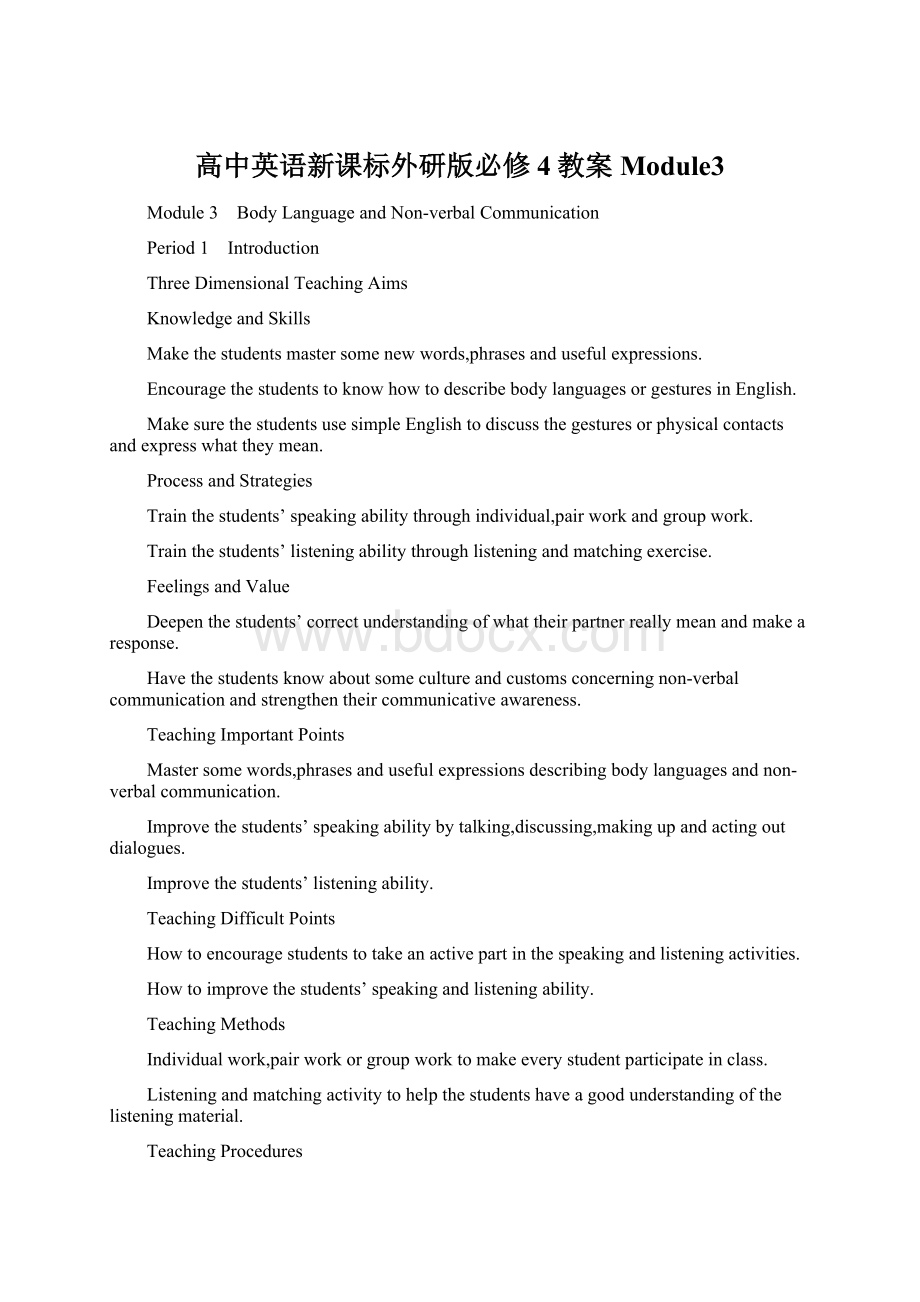高中英语新课标外研版必修4教案Module3.docx
《高中英语新课标外研版必修4教案Module3.docx》由会员分享,可在线阅读,更多相关《高中英语新课标外研版必修4教案Module3.docx(14页珍藏版)》请在冰豆网上搜索。

高中英语新课标外研版必修4教案Module3
Module3 BodyLanguageandNon-verbalCommunication
Period1 Introduction
ThreeDimensionalTeachingAims
KnowledgeandSkills
Makethestudentsmastersomenewwords,phrasesandusefulexpressions.
EncouragethestudentstoknowhowtodescribebodylanguagesorgesturesinEnglish.
MakesurethestudentsusesimpleEnglishtodiscussthegesturesorphysicalcontactsandexpresswhattheymean.
ProcessandStrategies
Trainthestudents’speakingabilitythroughindividual,pairworkandgroupwork.
Trainthestudents’listeningabilitythroughlisteningandmatchingexercise.
FeelingsandValue
Deepenthestudents’correctunderstandingofwhattheirpartnerreallymeanandmakearesponse.
Havethestudentsknowaboutsomecultureandcustomsconcerningnon-verbalcommunicationandstrengthentheircommunicativeawareness.
TeachingImportantPoints
Mastersomewords,phrasesandusefulexpressionsdescribingbodylanguagesandnon-verbalcommunication.
Improvethestudents’speakingabilitybytalking,discussing,makingupandactingoutdialogues.
Improvethestudents’listeningability.
TeachingDifficultPoints
Howtoencouragestudentstotakeanactivepartinthespeakingandlisteningactivities.
Howtoimprovethestudents’speakingandlisteningability.
TeachingMethods
Individualwork,pairworkorgroupworktomakeeverystudentparticipateinclass.
Listeningandmatchingactivitytohelpthestudentshaveagoodunderstandingofthelisteningmaterial.
TeachingProcedures
Step1Lead-in
T:
Inlastmodulewehavelearnedsomethingabouttrafficjamathomeandabroad.Todaywearegoingtolearnsomethingaboutcommunicationwithoutwordsbutbodylanguage.
T:
(Theteachershowsapileofpicturesofphysicalcontacts.)Hereareseveralpicturesconcerningphysicalcontactandbodylanguageorgestures.Youmaybefamiliarwithsomeofthem.DoyouknowhowtoexpresstheminEnglish?
Nowdiscusstheminpairsorgroups.Inafewminutes,I’llasksomestudentstotalkaboutthem.
(Thestudentsbegintodiscussthepictures.Andtheteachergoesaroundtheclassandjoinsthem.Afewminuteslater,theteachersaysthefollowing.)
Step2Matchtheverbsintheboxwiththepictures
Theteacherreadsthewords,followedbythestudentsandperformseachword’smeaningwithgestures.
T:
NowIdivideyouintofourgroups—Groupa,Groupb,GroupcandGroupd.EachgrouptryyourbesttothinkoutasmanyEnglishnamesconcerningallkindsofbodymovementsorgesturesaspossibleandthensendarepresentativetowritethemontheblackboard.Now5minutesforyoutoprepare.Youcanalsorefertoyourdictionary.
Step3Listenandmatchthesituationswiththepictures
T:
Inthispartyouaregoingtohearapieceoflisteningmaterial.Thefirsttimeyouneedtojustlistentothematerialandtrytogetthemainidea.
Listentoitagain.Thistimeyouneedtolistenverycarefullyandmakeeveryefforttogetthedetails.Meanwhile,matchthesituationswiththepictureabove.
Step4SayWhatYouDoWhenYou...
T:
Workinpairs.Actoutthemovementsandsaytherelevantwordsandexpressionsaccordingtothefollowingsituationsgiveninthisactivity.Fiveminutesforyoutoprepare.
Step5Readandanswerthequestions
T:
Inlastactivitysomestudentsperformedalotofsituations.Thisactivityisanopenone,sodifferentstudentshavedifferentopinions.ChooseananswerforExercise1andgivereasonsforyourchoice.
Step6Summaryandhomework
Inthisclasswe’vemainlylearnedsomethingaboutbodylanguagesbyspeakingandlistening,sowe’vegotmoreinformationaboutbodylanguagesandourspeakingandlisteningabilitieshavebeenimproved.Atthesametime,wehavelearntsomewords,suchaspoint,shake,smileandsomesituationsinwhichyouusebodylanguagesuchasmeetafriend,showsomeonetheway,saynoandsoon.
Homework
Rememberthemandlearntousethem.Afterclass,trytocollectmoreinformationaboutbodylanguageandpreparefornextpart—Readingandvocabulary.
TheDesignoftheWritingontheBlackboard
Module3 BodyLanguageandNon-verbalCommunication
Thefirstperiod
point,shake,smile,wave
show...theway
communicatewith
shakehands
RecordafterTeaching
__________________________________________________
__________________________________________________
__________________________________________________
Period2 ReadingandVocabulary
ThreeDimensionalTeachingAims
KnowledgeandSkills
Trainthestudents’readingability.
Learnsomeusefulwordsandexpressions.
Learnsomefactsaboutbodylanguage.
ProcessandStrategies
Makethestudentsknowmoreaboutbodylanguageandcommunicationcustomsaswellasculturesindifferentcountriesandareas.
FeelingsandValue
Makethestudentshaveabetterunderstandingofbodylanguageandnon-verbalcommunication.
Inspiretheirinterestindifferentcustomsandculturesofdifferentcountriesandareas.
Encouragethestudentstolearnandusesuchbodylanguagetocommunicatewitheachotherthroughtheiraction.
TeachingImportantPoints
Helpthestudentstounderstandthepassagebetter.
Learnandmastersomeimportantwordsandphrasesinthisperiod.
Howtoletthestudentsunderstandthebodylanguageindifferentcountriesandusethemcorrectly.
TeachingDifficultPoints
Howtohelpthestudentsimprovetheirreadingabilityandunderstandthepassagebetter.
HowtomastertheimportantLanguagePointsinthispassage.
TeachingMethods
Discussiontoleadinthereadingclass.
Fastreadingtogetthemainideaofthetext.
Intensivereadingtounderstandthepassagebetter.
ExplanationtohelpthestudentsmastersomeLanguagePoints.
TeachingProcedures
Step1Greetingsandrevision
T:
(Greetthewholeclassasusual.)Askthestudentstoacttheirdialogueout.
Step2Discussionandleadin
(Showthefollowingwordsandphrasesonthescreen.)
communication position unconscious aggressive gesture involve bow slap
spread bend hug stare formal informal communicatewith makeadeal mindreader holdup varyfrom...to... bebusywith giveaway onguard
Letthestudentsreadthewordsandphrasesaftertheteacher.Theteachercangiveabriefintroductiontothestudentsifnecessaryortheymaydiscusswiththeirpartners.
Theteachershowsthequestionsonthescreen.
1.Canyouguesswhatsomeoneisthinkingorfeelingbylookingattheirbodylanguage?
2.Dopeoplefromdifferentpartsoftheworldusedifferentbodylanguage?
WhataboutpeoplewholiveindifferentpartsofChina?
3.Howdoyoucommunicatethefollowingwithbodylanguage?
Thankyou!
No.Yes.Idon’tknow.Comehere.
Step3Fastreading
Readthepassagequicklyandsummarizethemainideaofeachparagraph.Afterafewminutes,theteacherchecksthemainideastheysummarize.
Step4Intensivereading
Thistimeyoushouldreadslowlyandcarefully.Showthefollowingquestionsonthescreen.
1.Notallbodylanguageisconscious.
2.Europeansshakehandswiththeirlefthand.
3.InAsia,peopletouchstrangerswhentheymeet.
4.IntheUSa“highfive”isawayofsayinghello.
5.A“highfive”isaformalgesture.
6.Bodylanguageislesscommunicativethanspokenorwrittenlanguage.
Suggestedanswers:
1.T 2.F 3.F 4.T 5.F 6.F
Step5Languagestudy
Ex.1Completethesentenceswiththewordsgiven.
(Theteachershowsthewordsandexerciseonthescreen.)
Aggressive
deal
gesture
greet
formal
informal
position
trust
unconscious
Weapon
1.Gunsandknivesaretwodifferenttypesof__________.
2.Someonewhohasa(n)__________attitudemaybeviolent.
3.Youcan__________someonebysaying“Hello”.
4.Your__________isthewayyouaresittingorstanding.
5.Ifyouare__________ofsomethingyoudonotknowitishappening.
6.A(n)__________isabusinessagreement.
7.A(n)__________isamovementofthebodytocommunicatesomething.
8.Ifyou__________someoneyoubelievethemandrelyonthem.
9.”Givemefive!
”isa(n)__________greeting.
10.Peopleareusuallymore__________withpeopletheydon’tknow.
1.weapons
2.aggressive
3.greet
4.position
5.unconscious
6.deal
7.gesture
8.trust
9.informal
10.formal
Ex.2TranslatethefollowingsentencesintoChinese.
1.Theweathervariesfromplacetoplace.
2.Theywereinvolvedinthematter.
3.Thechildrenstaredatthecolouredballons.
4.Wemadeadealandagreedtohelphimout.
5.Thegirlsarebusygreetingtheforeignersoverthere.
Step6Listeningandconsolidation
Listencarefully.Payattentiontothepronunciationandintonation.
Step7Summaryandhomework
T:
Inthisperiodwehavelearnedsomevocabularyandpleasetrytokeeptheminmindafterclass.Throughthereadingofthetextweknowsomethingaboutbodylanguageandnon-verbalcommunication.Wehavelearnedthatdifferentpeoplehavedifferentwaysofmakingcommunicationthroughbodylanguage.Afterclass,pleasereadthispassageagainandagaintillyoucanreciteitorretellitinyourownwords;meanwhile,tryyourbesttomastertheusefulexpressionsinthisperiod.What’smore,remembertopreviewGrammar1;Listeningandvocabulary.Thoughwearemakingmuchprogress,wehavealongwaytogo.Soitisourtasktostudyhardandmakegreateffortstospreadourculture.Somuchfortoday.Good-bye,everyone!
ActivitiesandResearch
1.Findoutmoreinformationaboutbodylanguage.
2.Encouragethestudentstousethebodylanguagetheyhavejustlearned.
TheDesignoftheWritingontheBlackboard
Module3 BodyLanguageandNon-verbalCommunication
Thesecondperiod
stareat
makeadeal
beinvolvedin
varyfrom...to...
bebusydoingsth.
RecordafterTeaching
_______________________________________________________________________
______________________________________________________________